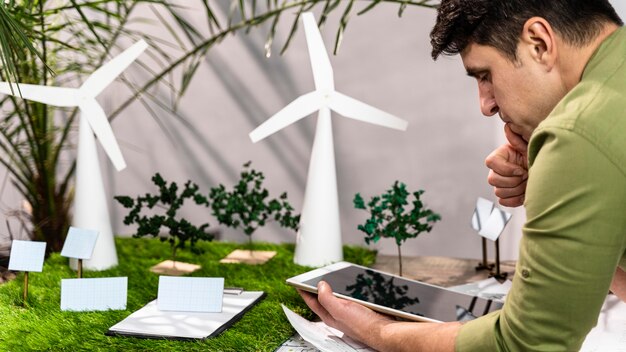Building near sensitive environments is a delicate undertaking that requires a balance between development and conservation. These environments, which may include wetlands, wildlife habitats, coastal areas, and forested regions, play a vital role in maintaining biodiversity, supporting ecosystems, and mitigating the effects of climate change. As construction projects continue to grow globally, it is increasingly important for developers, architects, and builders to adopt eco-conscious strategies when planning and executing projects near these sensitive areas.
Understanding Sensitive Environments
Sensitive environments refer to regions that are fragile and easily impacted by human activities. These include:
- Wetlands: Areas that are flooded or saturated with water for most of the year, which provide critical functions such as water filtration, flood control, and habitat for wildlife.
- Coastal Zones: These areas are highly vulnerable to erosion, rising sea levels, and pollution. They also serve as habitat for diverse marine and bird species.
- Forests: Forests play a crucial role in carbon sequestration and biodiversity, and their destruction can have significant impacts on both local and global ecosystems.
- Wildlife Habitats: Certain areas are home to endangered species that depend on their environment for survival. Development near these habitats requires careful planning to avoid disrupting animal migration patterns and breeding grounds.
Challenges of Building Near Sensitive Areas
The primary challenge of building near these environments is minimizing harm while ensuring that the development project meets its objectives. Some of the main challenges include:
- Habitat Disruption: Construction can destroy or fragment habitats, leaving wildlife with fewer areas to thrive.
- Pollution: Runoff from construction sites can pollute nearby water sources, harming aquatic life and spreading toxins to surrounding areas.
- Erosion and Flooding: Construction activities, especially in coastal or wetland areas, can increase soil erosion and reduce the land’s ability to absorb water, which leads to flooding.
- Noise and Light Pollution: Excessive noise and artificial light can disrupt wildlife behavior, especially in nocturnal species.
- Increased Traffic and Human Activity: Development brings more human presence to sensitive areas, potentially leading to the overuse of resources, disturbance to local wildlife, and introduction of invasive species.
Eco-Conscious Construction Practices
Despite these challenges, there are several best practices and strategies that can help minimize the environmental impact of construction near sensitive environments. Here are some eco-conscious construction approaches that developers can adopt:
Conduct Comprehensive Environmental Impact Assessments (EIAs)
Before starting any construction project, it is crucial to conduct a comprehensive environmental impact assessment (EIA). This assessment evaluates the potential effects of the development on nearby ecosystems, wildlife, and water resources. By identifying environmental risks early, the EIA enables developers to implement effective mitigation strategies. In Utah, this process also ensures compliance with the State’s Stormwater Pollution Prevention Plan (SWPPP) requirements, which aim to manage stormwater runoff and protect local water quality. Moreover, the EIA helps ensure adherence to relevant local, state, and federal environmental regulations.
Design with Nature in Mind
When designing buildings or infrastructure near sensitive environments, it is crucial to incorporate sustainable and environmentally friendly design principles. These might include:
- Building elevated structures: For construction near wetlands or flood-prone areas, building elevated structures can minimize disruption to the land while also reducing the risk of flooding.
- Using permeable materials: To prevent soil erosion and improve water runoff, permeable materials such as gravel, porous concrete, or permeable pavers should be used in parking lots, roads, and other paved areas.
- Preserving native vegetation: Minimizing tree removal and preserving existing vegetation helps maintain local ecosystems. Native plants are well adapted to local conditions and provide valuable habitats for wildlife.
Minimize Land Disturbance
Reducing the amount of land disturbed during construction helps protect local ecosystems and wildlife. This can be achieved by:
- Planning compact, low-impact developments: Opting for smaller footprints and minimizing excavation and grading reduces the risk of soil erosion, destruction of natural habitats, and pollution.
- Controlling construction practices: Implementing erosion control measures like silt fences, sediment traps, and temporary soil stabilization techniques can help protect water bodies from runoff and sedimentation.
Incorporate Green Building Techniques
Green building techniques aim to reduce the environmental impact of construction by focusing on energy efficiency, water conservation, and sustainable materials. Some key elements of green building include:
- Energy-efficient designs: Incorporating passive solar design, insulation, and energy-efficient windows can reduce the energy consumption of the building and lower its carbon footprint.
- Rainwater harvesting systems: Capturing and reusing rainwater can help reduce the demand on local water resources and minimize runoff into nearby water systems.
- Sustainable building materials: Use locally sourced, recycled, and low-impact materials for construction. Sustainable materials like bamboo, reclaimed wood, or recycled steel have a lower environmental impact than traditional building materials.
Maintain Biodiversity through Mitigation
In cases where development cannot avoid sensitive areas entirely, developers can employ mitigation strategies to minimize the ecological impact of the project. These strategies might include:
- Creating wildlife corridors: To ensure wildlife can continue to move through the area, developers can create green corridors that allow animals to safely navigate between habitats.
- Restoring habitats: For every habitat lost or disrupted during construction, developers can work to restore similar ecosystems elsewhere to maintain biodiversity.
- Building wildlife-friendly features: Incorporating birdhouses, bat boxes, or other wildlife-friendly elements into the design of buildings can help support local species.
In Conclusion
Building near sensitive environments requires careful planning and a strong commitment to sustainability. By prioritizing eco-conscious construction practices, developers can minimize the environmental impact of their projects while still contributing to economic growth and urban development. The key is to find a balance that respects the natural world while advancing human progress. Through responsible design, thoughtful construction, and mitigation efforts, it is possible to build in harmony with the environment, ensuring that these sensitive areas remain protected for generations to come.








Leave a Reply